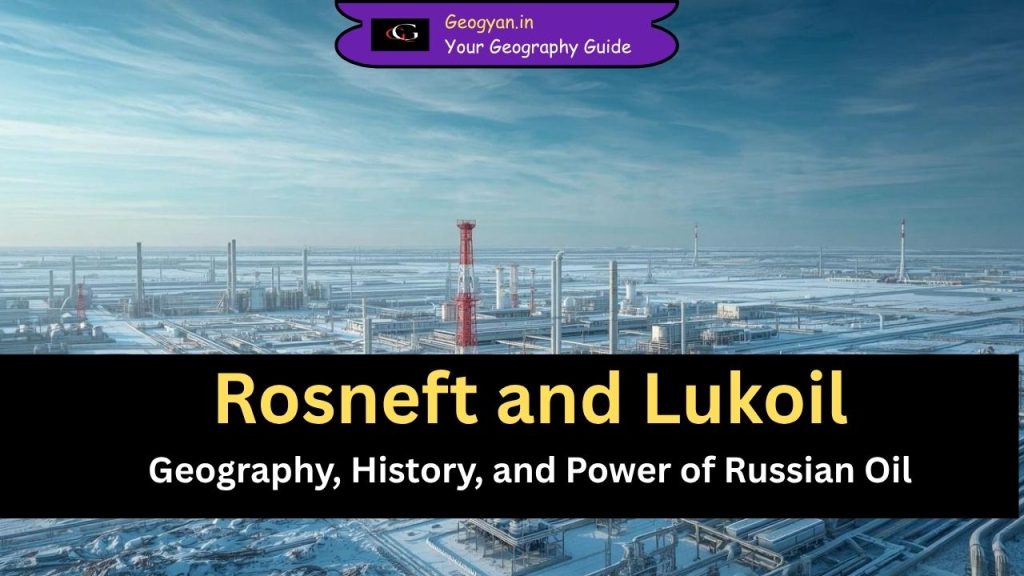Estimated reading time: 4 minutes

Table of contents
Why are Rosneft and Lukoil in the News?
In October 2025, the U.S. imposed sanctions on Russia’s largest oil companies Rosneft and Lukoil. These firms are pivotal suppliers of Russian crude oil to India. In response, Indian refiners including Reliance Industries and several PSUs are reviewing or suspending imports from Russia.
Why are these sanctions significant?
These sanctions target two major Russian oil-export companies. Together, Rosneft and Lukoil produce millions of barrels of oil per day and contribute deeply to Russia’s export revenues. The sanctions signal a serious escalation in Western efforts to limit Russia’s energy income.
For India, which imported over 30-40% of its crude from Russia in recent years, this development poses both strategic and economic challenges.
About Rosneft and Lukoil?
Rosneft
- Rosneft was founded in 1993, following the dissolution of the Soviet Union, when Russia began reorganizing its vast state-owned oil assets.
- It evolved from the remnants of the former Soviet Ministry of Oil and Gas and became the largest state-owned oil company in Russia.
- In the 2000s, Rosneft grew rapidly after acquiring assets from Yukos Oil Company, which was dismantled during President Vladimir Putin’s administration.
- Rosneft has joint ventures in India (with ONGC Videsh and Nayara Energy), Venezuela, China, and Egypt.
- Lukoil has international refining operations in Italy, Bulgaria, Romania, and Iraq, making it a globally diversified energy player.
Today, Rosneft plays a strategic role in Russia’s energy diplomacy, managing major upstream and downstream oil projects. It is responsible for over 40% of Russia’s total crude oil production and has partnerships with global firms in countries like India, China, and Venezuela.
Lukoil
- Lukoil, on the other hand, was established in 1991, making it one of Russia’s first private oil companies after the fall of the USSR.
- The name “Lukoil” derives from the initials of three Western Siberian oil-producing cities — Langepas, Urai, and Kogalym — combined with “oil.”
Unlike Rosneft, Lukoil remained largely privately owned and independently operated, becoming one of the largest non-state oil producers in the world. During the 1990s and 2000s, Lukoil expanded internationally, acquiring refining and retail assets in Europe, the United States, and Central Asia.
Geographical & Strategic Impact on India’s Energy Imports
1. India’s Heavy Reliance on Russian Crude
India became one of Russia’s top customers after 2022, exploiting steep discounts. Russian barrels helped meet India’s rising demand while reducing dependence on Middle-Eastern supplies.
2. Supply Chain Disruption & Oil Market Effects
With sanctions on Rosneft and Lukoil, India and China—two largest buyers of Russian seaborne oil—face pressure to find alternatives. l Rising global oil prices and supply bottlenecks may follow.
3. Geopolitical Geography at Play
Russia’s oil exports via seaborne shipments primarily go to Asia. If buyers reduce purchases, transport routes, logistics hubs and refining geography shift significantly. India may need to re-orient toward West Asia, Africa or Latin America.
What Options Does India Have?
India can ramp up imports from traditional suppliers: Saudi Arabia, UAE, Iraq and parts of Africa. It also may rely more on strategic petroleum reserves and diversify supply routes. But replacing large volumes of discounted Russian oil is complex in geographical terms—logistics, shipping time-zones and cost matter.
Key Facts (for Competitive Exams)
- Rosneft + Lukoil produce collectively around 5 million barrels per day.
- At one point, Russian crude made up roughly 35-40% of India’s total crude imports.
- Secondary sanctions warning by the U.S. might deter refineries from dealing with Russian firms.
- Geographic rerouting of oil supply could shift India’s refining-import map toward Africa, Latin America or Middle East.
Frequently Asked Questions (FAQs)
Q1. Why did the U.S. sanction Rosneft and Lukoil?
The U.S. accuses them of supplying finances to Russia’s war economy and blocking dollar-based transactions.
Q2. How much of India’s crude oil came from Russia?
Before the sanctions, estimates put Russian crude at over 30-40% of India’s total imports.
Q3. Will India immediately stop all Russian oil imports?
Not likely instantly. Refiners are reviewing contracts and compliance risks; some may gradually reduce imports.
Q4. Which countries could replace Russia as oil suppliers for India?
Saudi Arabia, UAE, Iraq, Africa (Angola, Nigeria), and Latin America are possible alternatives.
Q5. How will global oil geography change?
If major buyers reduce Russian oil purchases, major supply routes shift, alternate production will be sought, and shipping logistics will re-align.





























